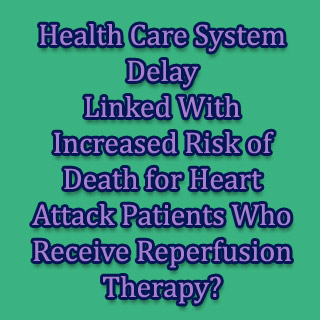
Patients with ST-segment elevation myocardial infarction (STEMI) which seems to be a certain pattern on an electrocardiogram following a heart attack can be administered with reperfusion therapy. The therapy can be possibly given along with fibrinolysis that is the dissolution of fibrin or primary percutaneous coronary intervention (PCI). It was affirmed that PCI is a procedure like balloon angioplasty or stent placement that may be employed for opening narrowed coronary arteries. Scientists believe that door-to-balloon delay is a performance measure in triaging patients for primary PCI.
Authors explain, “However, focusing on the time from first contact with the health care system to the initiation of reperfusion therapy (system delay) may be more relevant, because it constitutes the total time to reperfusion modifiable by the health care system. No previous studies have focused on the association between system delay and outcome in patients with STEMI treated with primary PCI.”
During the study investigators scrutinized the probable links between treatment, patient, system, and door-to-balloon delays and mortality in a large group of patients with STEMI treated with primary PCI. Christian Juhl Terkelsen, M.D., Ph.D., of Aarhus University Hospital, Aarhus, Denmark, and colleagues encompassed data from Danish medical registries of patients with STEMI transported by emergency medical service. These patients were treated with primary PCI from January 2002 to December 2008 at 3 high-volume PCI centers in Western Denmark.
Scientists share, “In multivariate analysis adjusted for other predictors of mortality, system delay was independently associated with mortality, as was its components, prehospital system delay and door-to-balloon delay. We conclude that health care system delay is valuable as a performance measure when patients with STEMI are treated with primary PCI, because it is associated with mortality, it constitutes the part of treatment delay modifiable by the health care system in the acute phase, and it applies to patients field-triaged directly to the PCI center as well as to patients transferred from local hospitals. Increased focus on the total health care system delay may optimize triage of patients with STEMI and may be the key to further improving survival of these patients.”
6,209 patients were subjected to primary PCI within 12 hours of symptom onset. The authors mention that the median follow-up time was 3.4 years. In accordance to intervals of system delay, long-term cumulative mortality appeared in 43 patients representing 15.4 percent. System delays of 0 through 60 minutes were observed in 347 patients comprising 23.3 percent. Delays of 61 through 120 minutes were apparently noted in 380 individuals. 2,643 patients presenting 28.1 percent and 378 were claimed to face delays of 121 through 180 minutes. Scientists found 2,092 and 275 representing 30.8 percent in delays of 181 through 360 minutes wherein 1,127 people were included.
The study is published in the August 18 issue of JAMA.
